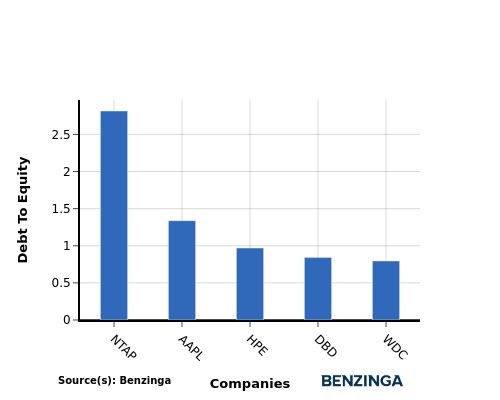In the dynamic and fiercely competitive business environment, conducting a thorough analysis of companies is crucial for investors and industry enthusiasts. In this article, we will perform an extensive industry comparison, evaluating Apple (NASDAQ:AAPL) in relation to its major competitors in the Technology Hardware, Storage & Peripherals industry. By closely examining crucial financial metrics, market position, and growth prospects, we aim to offer valuable insights for investors and shed light on company’s performance within the industry.
Apple Background
Apple is among the largest companies in the world, with a broad portfolio of hardware and software products targeted at consumers and businesses. Apple’s iPhone makes up a majority of the firm sales, and Apple’s other products like Mac, iPad, and Watch are designed around the iPhone as the focal point of an expansive software ecosystem. Apple has progressively worked to add new applications, like streaming video, subscription bundles, and augmented reality. The firm designs its own software and semiconductors while working with subcontractors like Foxconn and TSMC to build its products and chips. Slightly less than half of Apple’s sales come directly through its flagship stores, with a majority of sales coming indirectly through partnerships and distribution.
| Company | P/E | P/B | P/S | ROE | EBITDA (in billions) | Gross Profit (in billions) | Revenue Growth |
|---|---|---|---|---|---|---|---|
| Apple Inc | 36.52 | 54.59 | 9.82 | 39.36% | $35.55 | $48.34 | 7.94% |
| Western Digital Corp | 22.23 | 9.16 | 5.67 | 20.57% | $1.48 | $1.23 | 27.4% |
| Hewlett Packard Enterprise Co | 26.86 | 1.23 | 0.92 | 1.14% | $1.11 | $2.67 | 18.5% |
| Pure Storage Inc | 206.32 | 21.08 | 8.60 | 3.68% | $0.09 | $0.6 | 12.73% |
| NetApp Inc | 19.37 | 22.41 | 3.43 | 23.13% | $0.38 | $1.1 | 1.17% |
| Super Micro Computer Inc | 28.68 | 3.33 | 1.10 | 2.62% | $0.25 | $0.47 | -15.49% |
| Logitech International SA | 26.83 | 8.32 | 3.78 | 7.99% | $0.22 | $0.51 | 6.27% |
| Diebold Nixdorf Inc | 48.21 | 2.11 | 0.66 | 3.73% | $0.11 | $0.25 | 1.95% |
| Average | 54.07 | 9.66 | 3.45 | 8.98% | $0.52 | $0.98 | 7.5% |
table {
width: 100%;
border-collapse: collapse;
font-family: Arial, sans-serif;
font-size: 14px;
}
th, td {
padding: 8px;
text-align: left;
}
th {
background-color: #293a5a;
color: #fff;
text-align: left;
}
tr:nth-child(even) {
background-color: #f2f4f8;
}
tr:hover {
background-color: #e1e4ea;
}
td:nth-child(3), td:nth-child(5) {
text-align: left;
}
.dividend-amount {
font-weight: bold;
color: #0d6efd;
}
.dividend-frequency {
font-size: 12px;
color: #6c757d;
}
After thoroughly examining Apple, the following trends can be inferred:
-
The Price to Earnings ratio of 36.52 is 0.68x lower than the industry average, indicating potential undervaluation for the stock.
-
With a Price to Book ratio of 54.59, which is 5.65x the industry average, Apple might be considered overvalued in terms of its book value, as it is trading at a higher multiple compared to its industry peers.
-
The Price to Sales ratio of 9.82, which is 2.85x the industry average, suggests the stock could potentially be overvalued in relation to its sales performance compared to its peers.
-
The company has a higher Return on Equity (ROE) of 39.36%, which is 30.38% above the industry average. This suggests efficient use of equity to generate profits and demonstrates profitability and growth potential.
-
The company exhibits higher Earnings Before Interest, Taxes, Depreciation, and Amortization (EBITDA) of $35.55 Billion, which is 68.37x above the industry average, implying stronger profitability and robust cash flow generation.
-
Compared to its industry, the company has higher gross profit of $48.34 Billion, which indicates 49.33x above the industry average, indicating stronger profitability and higher earnings from its core operations.
-
The company’s revenue growth of 7.94% is notably higher compared to the industry average of 7.5%, showcasing exceptional sales performance and strong demand for its products or services.
Debt To Equity Ratio

The debt-to-equity (D/E) ratio provides insights into the proportion of debt a company has in relation to its equity and asset value.
Considering the debt-to-equity ratio in industry comparisons allows for a concise evaluation of a company’s financial health and risk profile, aiding in informed decision-making.
By analyzing Apple in relation to its top 4 peers based on the Debt-to-Equity ratio, the following insights can be derived:
-
Apple falls in the middle of the list when considering the debt-to-equity ratio.
-
This indicates that the company has a moderate level of debt relative to its equity with a debt-to-equity ratio of 1.34, suggesting a balanced financial structure with a reasonable debt-equitymix.
Key Takeaways
For Apple in the Technology Hardware, Storage & Peripherals industry, the PE, PB, and PS ratios indicate that the stock is relatively undervalued compared to its peers. However, the high ROE, EBITDA, gross profit, and revenue growth suggest that Apple is performing exceptionally well in terms of profitability and operational efficiency within the industry sector.
This article was generated by Benzinga’s automated content engine and reviewed by an editor.

Recent Comments